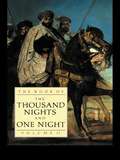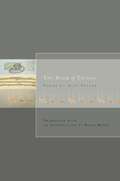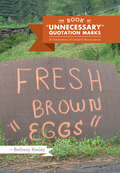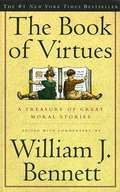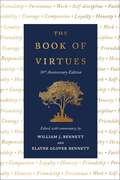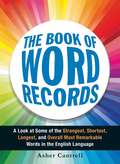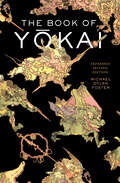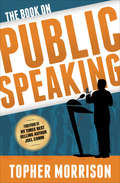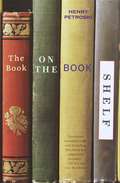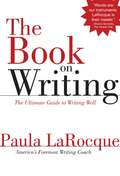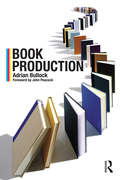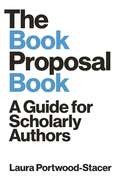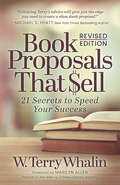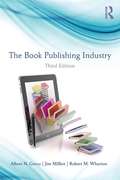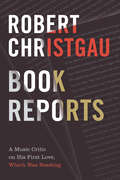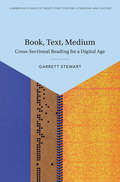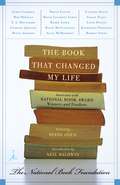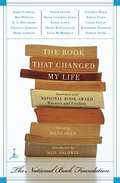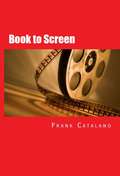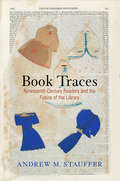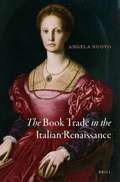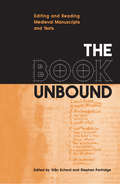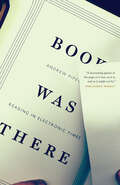- Table View
- List View
The Book of the Thousand Nights and One Night (Vol 2)
by Powys MathersFirst published in 1986. Routledge is an imprint of Taylor & Francis, an informa company.
The Book of Things
by Brian Henry Ales StegerFrom his first book of poems, Chessboards of Hours (1995), Aleš Šteger has been one of Slovenia's most promising poets. The philosophical and lyrical sophistication of his poems, along with his work as a leading book editor and festival organizer, quickly spread Šteger's reputation beyond the borders of Slovenia. The Book of Things is Šteger's most widely praised book of poetry and his first American collection. The book consists of fifty poems that look at "things" (i.e. aspirin, chair, cork) which are transformed by Šteger's unique poetic alchemy.Translator Brian Henry is a distinguished poet, translator, editor, and critic.From Publisher's Weekly:Steger's efforts sometimes bring to mind such Western European figures as Francis Ponge and Craig Raine, who also sought to make household things look new and strange. Yet Steger brings a melancholy Central European sense of history- his objects tend to remember, or cause, great pain: "It pours, this poisonous, sweet force," Steger writes of "Saliva," "Between teeth, when you spit your own little genocide." (Nov.)From Guernica, a Magazine of Art and Politics:It is a rare treat to have an English translation before the ink has dried on the original. By which I mean, a mere five years after the book's Slovenian publication, Brian Henry has brought these poems to life for those of us not lucky enough to read Slovenian. Henry's translations are impressive for sheer acrobatics.
The Book of Things (Lannan Translations Selection Series #18)
by Ales StegerFrom his first book of poems, Chessboards of Hours (1995), Aleš Šteger has been one of Slovenia's most promising poets. The philosophical and lyrical sophistication of his poems, along with his work as a leading book editor and festival organizer, quickly spread Šteger's reputation beyond the borders of Slovenia. The Book of Things is Šteger's most widely praised book of poetry and his first American collection. The book consists of fifty poems that look at "things" (i.e. aspirin, chair, cork) which are transformed by Šteger's unique poetic alchemy.Translator Brian Henry is a distinguished poet, translator, editor, and critic.From Publisher’s Weekly:Steger’s efforts sometimes bring to mind such Western European figures as Francis Ponge and Craig Raine, who also sought to make household things look new and strange. Yet Steger brings a melancholy Central European sense of history- his objects tend to remember, or cause, great pain: "It pours, this poisonous, sweet force,” Steger writes of "Saliva,” "Between teeth, when you spit your own little genocide.” (Nov.)From Guernica, a Magazine of Art and Politics:It is a rare treat to have an English translation before the ink has dried on the original. By which I mean, a mere five years after the book’s Slovenian publication, Brian Henry has brought these poems to life for those of us not lucky enough to read Slovenian. Henry’s translations are impressive for sheer acrobatics.
The Book of "Unnecessary" Quotation Marks: A Celebration of Creative Punctuation
by Bethany KeeleyFrom the popular blog, a hilarious and horrifying survey of quotation mark abuse in all its forms.From the sarcastic to the suggestive, here are quotation marks as we love them best, doing horrible damage to the English language. Who wouldn’t have second thoughts about ordering the “hamburger” on the diner’s menu? Would it be best to skip the “blowout” sale at the department store? What hidden price must be paid for something marked “free”? Assembled by the creator of the wildly popular “Blog” of “Unnecessary” Quotation Marks, this book surveys the havoc wreaked by quotation marks on signs, menus, placards, and posters that leave reality upended by supposed “facts.” This smarty-pants guide is “perfect” for desperate grammarians, habitual air quoters, and anyone who appreciates a good laugh.
The Book of Virtues: A Treasury Of Great Moral Stories (Book Of Virtues Collection)
by William J. BennettResponsibility. Courage. Compassion. Honesty. Friendship. Persistence. Faith. Everyone recognizes these traits as essentials of good character. In order for our children to develop such traits, we have to offer them examples of good and bad, right and wrong. And the best places to find them are in great works of literature and exemplary stories from history. William J. Bennett has collected hundreds of stories in The Book of Virtues, an instructive and inspiring anthology that will help children understand and develop character -- and help adults teach them. From the Bible to American history, from Greek mythology to English poetry, from fairy tales to modern fiction, these stories are a rich mine of moral literacy, a reliable moral reference point that will help anchor our children and ourselves in our culture, our history, and our traditions -- the sources of the ideals by which we wish to live our lives. Complete with instructive introductions and notes, The Book of Virtues is a book the whole family can read and enjoy -- and learn from -- together.
The Book of Virtues: 30th Anniversary Edition
by William J. Bennett Elayne Glover BennettHelp your children develop moral character with this updated, 30th anniversary edition of the perennial classic Book of Virtues.Almost 3 million copies of the Book of Virtues have been sold since it was published in 1993. It is one of the most popular moral primers ever written, an inspiring anthology that helps children understand and develop character—and helps parents teach it to them. Thirty years ago, readers thought that the times were right for a book about moral literacy. Back then, Americans worried that schools were no longer parents&’ allies in teaching good character. As the book&’s original introduction noted, &“moral anchors and moorings have never been more necessary.&” If that was true in the 1990s, it is even more true today. The explosion of information with the Internet has left many unsure of what is valuable and what is not. Responsibility. Courage. Compassion. Loyalty. Honesty. Friendship. Persistence. Hard work. Self-discipline. Faith. These remain the essentials of good character. The Book of Virtues contains hundreds of exemplary stories offering children examples of good and bad, right and wrong. Drawing on the Bible, American history, Greek mythology, English poetry, fairy tales, and modern fiction, William J. and Elayne Bennett show children the many virtuous paths they can follow—and the ones they ought to avoid. For the 30th anniversary edition, the Bennetts have slimmed down the book&’s contents, while also finding room to introduce such figures as Mother Teresa, Colin Powell, and heroes of 9/11 and the War in Afghanistan. Here is a rich mine of moral literacy to teach a new generation of children about American culture, history, and traditions—ultimately, the ideals by which we wish to live our lives. The updated edition of The Book of Virtues will continue a legacy of raising moral children far into a new century.
The Book of Word Records: A Look at Some of the Strangest, Shortest, Longest, and Overall Most Remarkable Words in the English Language
by Asher CantrellFrom antidisestablishmentarianism to zo, a unrivaled collection of today's greatest words!Have you ever wondered what the longest word in the dictionary is? Or the origin of your go-to curse word?With The Book of Word Records, you'll uncover hundreds of bizarre, ugly, gross, and otherwise extreme words that have what it takes to break some serious records. From the seven longest speeches ever given to twelve of the most popular passwords used today, each of these entries reveals the history behind the world's most noteworthy expressions and fascinating details on how they stack up against the competition. You'll also learn how to step up your vocabulary with pronunciations, definitions, and sample sentences for each award-winning word.Whether you're a Scrabble champ looking to get a high score or just want to impress those around you, The Book of Word Records is sure to surprise even the most skilled wordsmith with its one-of-a-kind superlative lists.
The Book of Yokai, Expanded Second Edition: Mysterious Creatures of Japanese Folklore
by Michael Dylan FosterSignificantly expanded and updated—a lively excursion into Japanese folklore and its increasing influence within global popular culture. Monsters, spirits, fantastic beings, and supernatural creatures haunt the folklore and popular culture of Japan. Broadly labeled yōkai, they appear in many forms, from tengu mountain goblins and kappa water sprites, to shape-shifting kitsune foxes and long-tongued ceiling-lickers. Popular today in anime, manga, film, and video games, many yōkai originated in local legends, folktales, and regional ghost stories. The Book of Yōkai invites readers to examine how people create, transmit, and collect folklore, and how they make sense of the mysteries in the world around them. Revised and expanded, this second edition features fifty new illustrations, including an all-new yōkai gallery of stunning color images tracing the visual history of yōkai across centuries. In clear and accessible language, Michael Dylan Foster unpacks the cultural and historical contexts of yōkai, interpreting their varied meanings and introducing people who have pursued them through the ages.
The Book on Public Speaking
by Topher Morrison&“One of the most powerful professional speakers in America . . . reveals how he&’s earned millions onstage, on camera and in business&” (Steve Siebold, CSP, past chairman of The National Speakers Association&’s Million Dollar Speakers Group). If you look at the trends of over thirty years ago in fashion, technology, architecture, and any other industry, what was cutting edge back then has become cliché and grossly out of date now. But in the speaking industry, most people get up and still walk, talk, and sound like the 1980s motivational speakers of yesteryear. The Book on Public Speaking takes a head-on approach and challenges the status quo for business leaders that speak in front of their staff, board of directors, and the public. After reading this book you will be privy to the most current methods for speaking to an audience for maximum impact in today&’s more sophisticated and skeptical culture. If you are the type of business leader who has achieved a level of success in life and feel compelled to share your story with the world, don&’t lessen that impact by imitating outdated speaking techniques. Instead, break the mold of the speaker cliché and tap into a speaking style that is authentic, packs a punch, and leaves the audience wanting more. &“I learned some amazing presentation techniques from Topher. I&’m using them right now. They&’re awesome. You can&’t tell because you&’re reading this.&” —John Heffron, winner of The Last Comic Standing &“Morrison is crazy good at training you how to communicate on-camera so that your business gets more attention.&” —James Lavers, professional speaker, founder, &“Selling from the Screen&”
The Book on the Bookshelf
by Henry PetroskiFrom the author of the highly praised The Pencil and The Evolution of Useful Things comes another captivating history of the seemingly mundane: the book and its storage.Most of us take for granted that our books are vertical on our shelves with the spines facing out, but Henry Petroski, inveterately curious engineer, didn't. As a result, readers are guided along the astonishing evolution from papyrus scrolls boxed at Alexandria to upright books shelved at the Library of Congress. Unimpeachably researched, enviably written, and charmed with anecdotes from Seneca to Samuel Pepys to a nineteenth-century bibliophile who had to climb over his books to get into bed, The Book on the Bookshelf is indispensable for anyone who loves books.From the Trade Paperback edition.
The Book On Writing: The Ultimate Guide To Writing Well
by Paula LarocqueYou're going to love the way Paula LaRocque teaches in The Book on Writing. A celebrated writing coach with a sense of humor and a gentle touch, she's also a master writer herself with a long and distinguished career in both teaching and practicing the art of writing. The Book on Writing contains 25 chapters in three sections: A dozen essential but easy-to-apply guidelines to good writing, from the importance of clarity to the value of a conversational tone. Paula LaRocque believes learning is easier and more successful when we are not only told but also shown. So her Book on Writing is chockfull of actual writing examples that supplement and illustrate principles that apply as naturally to fiction as they do to nonfiction. How to tell a story from building suspense, to effective description, to the uses of metaphor and literary devices. Paula LaRocque also deals with the narrative engine and the value of the archetype in plotting and characterization as well as with pace and speed and leveling what she terms the speedbumps in writing. A clear and concise handbook that deals with common problems in grammar, usage, punctuation, and style'the kind of problems that often trouble even wordsmiths. The handbook also debunks pesky language rules that are actually myths. The Book on Writing is one-stop shopping for writers. Read it once, and you'll be a better writer. Read it often, and you'll be among the best.
Book Production
by Adrian BullockThe digital revolution has brought with it a wider range of options for creating and producing print on paper products than ever seen before. With the growing demand for skills and knowledge with which to exploit the potential of digital technology, comes the need for a comprehensive book that not only makes it possible for production staff, editors, and designers to understand how the technology affects the industry they work in, but also provides them with the skills and competencies they need to work in it smartly and effectively. This book is designed to satisfy this need. Book Production falls into two parts: The first part deals with the increasingly important role of production as project managers, a role which has not been adequately written about in any of the recent literature on publishing. The second part deals with the processes and raw materials used in developing and manufacturing print on paper products. Case studies are used to illustrate why and how some processes or raw materials may or may not be appropriate for a particular job. With expert opinions and case studies, and a consideration of the practices and issues involved, this offers a comprehensive overview of book production for anyone working, or training to work in or in conjunction with the books industry.
The Book Proposal Book: A Guide for Scholarly Authors (Skills for Scholars)
by Laura Portwood-StacerA step-by-step guide to crafting a compelling scholarly book proposal—and seeing your book through to successful publicationThe scholarly book proposal may be academia’s most mysterious genre. You have to write one to get published, but most scholars receive no training on how to do so—and you may have never even seen a proposal before you’re expected to produce your own. The Book Proposal Book cuts through the mystery and guides prospective authors step by step through the process of crafting a compelling proposal and pitching it to university presses and other academic publishers.Laura Portwood-Stacer, an experienced developmental editor and publishing consultant for academic authors, shows how to select the right presses to target, identify audiences and competing titles, and write a project description that will grab the attention of editors—breaking the entire process into discrete, manageable tasks. The book features over fifty time-tested tips to make your proposal stand out; sample prospectuses, a letter of inquiry, and a response to reader reports from real authors; optional worksheets and checklists; answers to dozens of the most common questions about the scholarly publishing process; and much, much more.Whether you’re hoping to publish your first book or you’re a seasoned author with an unfinished proposal languishing on your hard drive, The Book Proposal Book provides honest, empathetic, and invaluable advice on how to overcome common sticking points and get your book published. It also shows why, far from being merely a hurdle to clear, a well-conceived proposal can help lead to an outstanding book.
Book Proposals That Sell: 21 Secrets to Speed Your Success
by W. Terry WhalinDiscover the Secrets to Getting Published. Writing a book? In the beginning stages of writing a book, most people start with a blank page and write their entire manuscript. According to author and acquisitions editor W. Terry Whalin, this approach is backwards. About 80% to 90% of nonfiction books are sold from a book proposal. This mysterious document called a proposal contains many elements that will never appear in a manuscript—yet these details are critical to publishing executives who make the decision about publishing or rejecting an author’s project. In Book Proposals That Sell, Terry reveals 21 secrets to creating a book proposal that every author needs in order to create one that sells.
The Book Publishing Industry (Mass Communications Book Ser.)
by Albert N. GrecoThe Book Publishing Industry focuses on consumer books (adult, juvenile, and mass market paperbacks) and reviews all major book categories to present a comprehensive overview of this diverse business. In addition to the insights and portrayals of the U.S. publishing industry, this book includes an appendix containing historical data on the industry from 1946 to the end of the twentieth century. The selective bibliography includes the latest literature, including works in marketing and economics that has a direct relationship with this dynamic industry. This third edition features a chapter on e-books and provides an overview of the current shift toward digital media in the US book publishing industry.
Book Reports: A Music Critic on His First Love, Which Was Reading
by Robert ChristgauIn this generous collection of book reviews and literary essays, legendary Village Voice rock critic Robert Christgau showcases the passion that made him a critic—his love for the written word. Many selections address music, from blackface minstrelsy to punk and hip-hop, artists from Lead Belly to Patti Smith, and fellow critics from Ellen Willis and Lester Bangs to Nelson George and Jessica Hopper. But Book Reports also teases out the popular in the Bible and 1984 as well as pornography and science fiction, and analyzes at length the cultural theory of Raymond Williams, the detective novels of Walter Mosley, the history of bohemia, and the 2008 financial crisis. It establishes Christgau as not just the Dean of American Rock Critics, but one of America's most insightful cultural critics as well.
Book, Text, Medium: Cross-Sectional Reading for a Digital Age (Cambridge Studies in Twenty-First-Century Literature and Culture)
by Garrett StewartBook, Text, Medium: Cross Sectional Reading for a Digital Age utilizes codex history, close reading, and language philosophy to assess the transformative arc between medieval books and today's e-books. It examines what happens to the reading experience in the twenty-first century when the original concept of a book is still held in the mind of a reader, if no longer in the reader's hand. Leading critic Garrett Stewart explores the play of mediation more generally, as the concept of book moves from a manufactured object to simply the language it puts into circulation. Framed by digital poetics, phonorobotics, and the rising popularity of audiobooks, this study sheds new light on both the history of reading and the negation of legible print in conceptual book art.
The Book That Changed My Life: Interviews with National Book Award Winners and Finalists
by Neil Baldwin Diane OsenEvery reader can name at least one book that changed his or her life--and many more beloved titles will surely come to mind as well. In The Book That Changed My Life, fifteen of America's most influential authors discuss their own special literary choices. These unique interviews with National Book Award winners and finalists offer new insights into the many ways in which the experience of reading shapes the act of writing. Robert Stone on Joseph Conrad's Victory, Cynthia Ozick on Henry James's Washington Square, Charles Johnson on Jack London's The Sea-Wolf--each approaches the question of literary influence, while offering rich and wonderful revelations about his or her own writing career. James Carroll, Don DeLillo, E. L. Doctorow, Diane Johnson, Philip Levine, David Levering Lewis, Barry Lopez, David McCullough, Alice McDermott, Grace Paley, Linda Pastan, and Katherine Paterson are the other distinguished contributors to this collection of informed, insightful interviews.From the Trade Paperback edition.
The Book That Changed My Life: Interviews with National Book Award Winners and Finalists
by Diane OsenEvery reader can name at least one book that changed his or her life. In The Book That Changed My Life, fifteen of America's most influential authors discuss their own special literary choices. These unique interviews with National Book Award winners and finalists offer new insights into the many ways in which the experience of reading shapes the act of writing. Robert Stone on Joseph Conrad's Victory, Cynthia Ozick on Henry James's Washington Square, Charles Johnson on Jack London's The Sea-Wolf-- each approaches the question of literary influence, while offering rich and wonderful revelations about his or her own writing career.
Book to Screen (How to Adapt Your Novel to a Screenplay #5)
by Frank CatalanoADAPTING YOUR NOVEL INTO A SCREENPLAY BOOK TO SCREEN was first presented as part of the 25th Annual Writer's Conference sponsored by San Diego State University on February 6 through the 8th, 2009 at the Double Tree Hilton Hotel in Mission Hills, California. The following transcript was presented and recorded by Frank Catalano as part of the programs offered at the conference. The book is based partly upon that presentation, focuses on the adaptation of an existing novel into a screenplay for presentation as a motion picture, television program or Internet content. Writers of fiction and non-fiction and industry professionals from the publishing business primarily attended the 25th Annual Writer's Conference. Mr. Catalano's seminars focused upon those writers seeking to adapt their novels into screenplays. The complete list of seminar presentations by Frank Catalano for this conference is: BOOK 1: WRITE GREAT CHARACTERS IN THE FIRST TEN PAGES BOOK 2: WRITING ON YOUR FEET - IMPROVISATIONAL TECHNIQUES FOR WRITERS - Part 1 BOOK 3: START YOUR STORY AT THE END BOOK 4: THE FIRST TEN PAGES BOOK 5: BOOK TO SCREEN BOOK 6: ACTING IT OUT - IMPROVISATIONAL TECHNIQUES FOR WRITERS - Part 2 BOOK 7: WRITE GREAT DIALOGUE
Book Traces: Nineteenth-Century Readers and the Future of the Library (Material Texts)
by Andrew M. StaufferIn most college and university libraries, materials published before 1800 have been moved into special collections, while the post-1923 books remain in general circulation. But books published between these dates are vulnerable to deaccessioning, as libraries increasingly reconfigure access to public-domain texts via digital repositories such as Google Books. Even libraries with strong commitments to their print collections are clearing out the duplicates, assuming that circulating copies of any given nineteenth-century edition are essentially identical to one another. When you look closely, however, you see that they are not.Many nineteenth-century books were donated by alumni or their families decades ago, and many of them bear traces left behind by the people who first owned and used them. In Book Traces, Andrew M. Stauffer adopts what he calls "guided serendipity" as a tactic in pursuit of two goals: first, to read nineteenth-century poetry through the clues and objects earlier readers left in their books and, second, to defend the value of keeping the physical volumes on the shelves. Finding in such books of poetry the inscriptions, annotations, and insertions made by their original owners, and using them as exemplary case studies, Stauffer shows how the physical, historical book enables a modern reader to encounter poetry through the eyes of someone for whom it was personal.
The Book Trade In The Italian Renaissance
by Angela NuovoThis work offers the first English-language survey of the book industry in Renaissance Italy. Where traditional accounts of the book in the Renaissance celebrate authors and literary achievement, this study examines the nuts and bolts of a rapidly expanding trade that built on existing economic practices while developing new mechanisms in response to political and religious realities. <p><p> Approaching the book trade from the perspective of its publishers and booksellers, this archive-based account ranges across family ambitions and warehouse fires to publishers' petitions and convivial bookshop conversation. In the process it constructs a nuanced picture of trading networks, production, and the distribution and sale of printed books, a profitable but capricious commodity.
The Book Unbound: Editing and Reading Medieval Manuscripts and Texts
by Siân EchardIn The Book Unbound, scholars and editors examine how best to use new technological tools and new methodologies with artifacts of medieval literature and culture. Taking into consideration English, French, Anglo-Norman, and Latin texts from several periods, the contributors examine and re-evaluate traditional approaches to and conclusions about medieval books and the cultural texts they contain - literary, dramatic, legal, historical, and musical. The essays range from detailed examinations of specific codices to broader theoretical discussions on past and present editorial practices, from the benefits and disadvantages of digital editions versus print editions to the importance of including 'extratextual' material such as variant texts, illustrations, intertexts, and other information about a work's cultural contexts, history, and use. The Book Unbound presents important contributions to the discussions surrounding the editing of medieval texts, including the use of digital technology with historical and literary documents, while offering practical ideas on editing print and hypertext. The collection will be invaluable to historians, literary scholars, and editors.
Book Was There: Reading in Electronic Times
by Andrew PiperAndrew Piper grew up liking books and loving computers. While occasionally burying his nose in books, he was going to computer camp, programming his Radio Shack TRS-80, and playing Pong. His eventual love of reading made him a historian of the book and a connoisseur of print, but as a card-carrying member of the first digital generation--and the father of two digital natives--he understands that we live in electronic times. Book Was There is Piper's surprising and always entertaining essay on reading in an e-reader world. Much ink has been spilled lamenting or championing the decline of printed books, but Piper shows that the rich history of reading itself offers unexpected clues to what lies in store for books, print or digital. From medieval manuscript books to today's playable media and interactive urban fictions, Piper explores the manifold ways that physical media have shaped how we read, while also observing his own children as they face the struggles and triumphs of learning to read. In doing so, he uncovers the intimate connections we develop with our reading materials--how we hold them, look at them, share them, play with them, and even where we read them--and shows how reading is interwoven with our experiences in life. Piper reveals that reading's many identities, past and present, on page and on screen, are the key to helping us understand the kind of reading we care about and how new technologies will--and will not--change old habits. Contending that our experience of reading belies naive generalizations about the future of books, Book Was There is an elegantly argued and thoroughly up-to-date tribute to the endurance of books in our ever-evolving digital world.
The Book Whisperer
by Jeff Anderson Donalyn MillerDonalyn Miller says she has yet to meet a child she couldn't turn into a reader. No matter how far behind Miller's students might be when they reach her 6th grade classroom, they end up reading an average of 40 to 50 books a year. Miller's unconventional approach dispenses with drills and worksheets that make reading a chore. Instead, she helps students navigate the world of literature and gives them time to read books they pick out themselves. Her love of books and teaching is both infectious and inspiring. The book includes a dynamite list of recommended "kid lit" that helps parents and teachers find the books that students really like to read.
